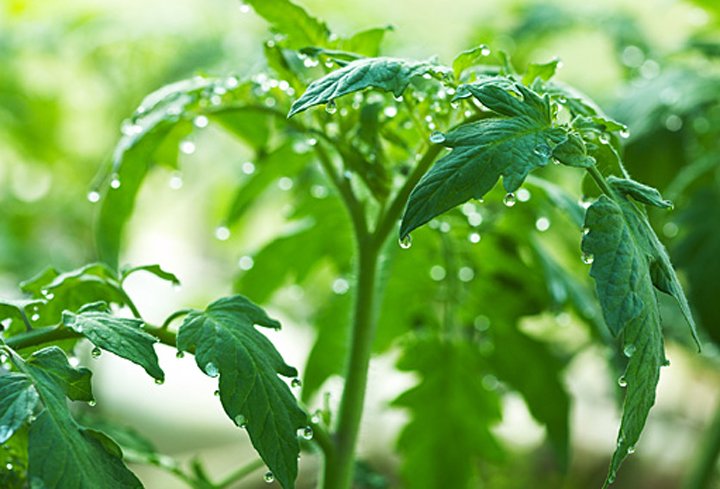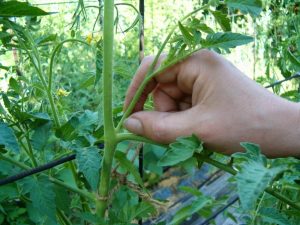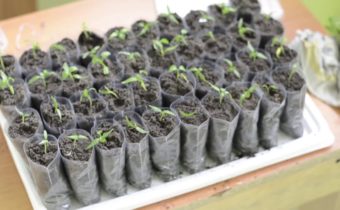If tomatoes zhirut, what to do?

Sometimes strong and healthy-looking tomato bushes do not end up bearing fruit. This indicates that the plant is fattening. What to do in this situation, and how to cope with the problem, you can learn from the article.
Signs of tomato fattening
 Tomatoes can begin to fatten in conditions of open soil, and in the greenhouse. But more often it happens in the second case. Experienced gardeners at a glance can determine the pathology. Beginners, on the other hand, often rejoice at powerful plants and begin to care for them even more diligently, without taking into account the norms of nutrients and watering. And only then when the ovaries begin to appear, inexperienced gardeners realize that something is wrong.
Tomatoes can begin to fatten in conditions of open soil, and in the greenhouse. But more often it happens in the second case. Experienced gardeners at a glance can determine the pathology. Beginners, on the other hand, often rejoice at powerful plants and begin to care for them even more diligently, without taking into account the norms of nutrients and watering. And only then when the ovaries begin to appear, inexperienced gardeners realize that something is wrong.
To fattening tomatoes indicate thickened stems of plants, as well as compacted and twisted leaves. The plant is actively increasing the green mass. Sometimes the bushes stop developing. Ovaries are formed slowly or completely absent. The yield of such a plant is significantly reduced.
Causes of fattening
Often the reasons for fattening tomatoes lie in the wrong care for the culture. But in order not to repeat the mistake, you need to find out what exactly was done wrong.
- High humidity and lack of sunlight is one of the most common reasons for growing tomatoes in a greenhouse. But the thing is that the plants are planted too close to each other, they shade the neighboring bushes and poorly ventilated.
- Wrong fertilization can provoke this pathology. For example, some gardeners do not know that the introduction of fresh manure is unacceptable. Also, it is not recommended to introduce nitrogen at the stage of fruit formation, since this element is responsible for the growth of greenery. It is used only at the beginning of the growing season.
- Non-compliance with the variety agrotechnics. This is mostly true for indeterminant tomatoes, which need regular removal of the stepsons and pinch point growth.
- Excessive watering can adversely affect the plants, as in this case, all the forces go to the development of the root system, and the formation of the fruits of the forces no longer remains.
Preventive measures
 As with any disease, fattening tomatoes is better to prevent. First, it is necessary to observe the recommended distance between plants during planting. From the first days of the seedlings must be provided with sufficient sunlight. On adult bushes periodically thin out the foliage, from one plant they tear a couple of leaves a week. Also do not forget about pasynkovane. On determinants plants remove lower foliage before the first brush. It is also necessary to approach irrigation responsibly, watering plants only after the topsoil has dried, it is not possible to overpower tomatoes.
As with any disease, fattening tomatoes is better to prevent. First, it is necessary to observe the recommended distance between plants during planting. From the first days of the seedlings must be provided with sufficient sunlight. On adult bushes periodically thin out the foliage, from one plant they tear a couple of leaves a week. Also do not forget about pasynkovane. On determinants plants remove lower foliage before the first brush. It is also necessary to approach irrigation responsibly, watering plants only after the topsoil has dried, it is not possible to overpower tomatoes.
When growing tomatoes in the greenhouse, it must be regularly aired in order to normalize the humidity. You can also mulch the soil, it will reduce the amount of watering, and protect plants from weeds and the occurrence of pathogenic microflora. Before you conduct dressing, you need to carefully study the information on the timing of the application and the necessary substances for tomatoes. Nitrogen-containing substances contribute only in the period of active growth, in moderation.During the flowering period, this substance is excluded.
How to deal with fat burning?
 To successfully eliminate the problem, first of all, you need to find out the cause. When it is revealed, you can proceed to action.
To successfully eliminate the problem, first of all, you need to find out the cause. When it is revealed, you can proceed to action.
- correctly write the schedule for making dressings;
- reduce watering to a minimum;
- when making potash supplements it is necessary to take into account that it is advisable to use them only at the beginning of flowering;
- fattening tomatoes can be sprayed with phosphate fertilizers;
- comply with agricultural varieties;
- avoid fluctuations in air temperature;
- eliminate nitrogen fertilizers;
- Thin out the leaves on the bush;
- Crop bottom stems.
For fertilizing the soil when fattening tomatoes can be used: potassium nitrate, wood ash solution, potassium chloride or monophosphate, as well as magnesium sulfate. You can also use superphosphate, it suppresses the formation of greenery and promotes sticking and growth of fruits. The main thing is to properly prepare the solution for feeding, for this you need 12 liters of water at room temperature and 3 tbsp. spoons of fertilizer. They are sprayed with tomatoes or watered at the root, using a liter of water per bush.
Conclusion
Fattening tomatoes is a huge problem for the gardener, because of her you can lose the harvest. Therefore, when buying seeds you need to learn how to care for this variety. With the observance of agricultural engineering and the correct application of fertilizers, the problem will not arise. But, and if the tomatoes have already begun to fatten, you should immediately take action.





